|
|
 |
| Welcome | Getting Started | Resources | Site Map |
Week 3
Protein Sources |
Instructions for listening to audio clips
- Download the QuickTime Player to listen to the audio files.
- Read the QuickTime Instructions for installation help.
- Download the RealPlayer to listen to the audio files
- Instructions are on the RealPlayer download page
Oilseed Meals
Time: 12.43
Follow along with the audio...
- In U.S., high oil seeds for human foodstuffs and industrial products
- Oilseed meals are by-products
- Table 6.1 – Total and relative amounts of oilseeds produced in U.S. in 2001
Oilseed |
Crop Year - 2001 |
|---|---|
Soybeans for beans |
78,668 |
Cottonseed |
6,834 |
Peanuts |
1,923 |
Sunflower |
1,579 |
Canola |
907 |
In
1,000 metric tons; One metric ton equals 2,204.6 pounds |
|
*Estimated |
|
- In U.S., primary oilseed meals fed soybean and cottonseed
- Processing methods to remove oil from seed
- Screw press or expeller
- Cracked, dried, cooked, and extruded
- Temperature regulated
- Inactivate antinutritional factors
- Maintain nutritional value
- Maillard or browning reaction
- Bind carbohydrates and amino acids
- Reduce nutritional (protein) value of feedstuff
- Maillard or browning reaction
- Oilseeds have greatest lipid content
- Screw press or expeller
- Direct solvent
- Cracked, cooked, ground, and extracted
- Heated during solvent recovery
- Inactivate antinutritional factors
- Prepress solvent
- Modified expeller process with solvent extraction
- Oilseed meal with lowest lipid content
- General nutritional value
- Table 6.2 on page 89 of text nutrient compositions of oilseed meals
- Protein
- Quantity
- Minimal 40% CP (DM basis)
- Quality
- True protein
- Digestible
- Moderate to good biological value
- Low in cystine and methionine
- Lysine variable; low in all except soybean meal
- Quantity
- Energy value
- Varies
- Minerals
- Low in calcium
- High in phosphorus; relatively unavailable
- Vitamins
- Low to moderate in B-complex vitamins
- Low in E and carotene
- Soybean meal
- Most important protein supplement for animals
- Figure 6.1 – Field of immature soybeans
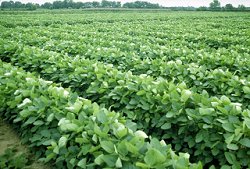
- Figure 6.2 - Mature soybean plant
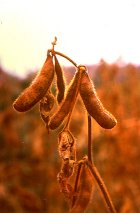
- Figure 6.3 – Soybean meal
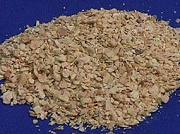
- Nutritional value
- Highest nutritional value of plant protein sources
- 44 or 55% CP (AF basis)
- Amino acid profile
- Favorable
- Low in methionine, cystine, and tryptophan
- High energy
- Low fiber
- Low in Ca, P, carotene, vitamin D, and B-complex vitamins
- Palatable and digestible
- Antinutritional factors
- Protease inhibitors, lectins, phytoestrogens, saponins, goitrogens, and others
- Heat effectively address
- Processing
- Solvent extraction
- Subsequently toasted
- Feeding livestock
- Excellent results for monogastrics and ruminants
- Other soybean-based products
- Whole, dehulled, solvent-extracted meal, ground, extruded whole beans or full-fat meal, and soy flour
- Cottonseed meal
- Figure 6.4 - Cotton seed
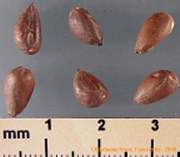
- Figure 6.5 – Cottonseed meal
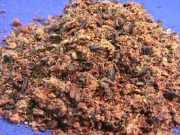
- Nutritional value
- 41% CP (AF basis); 44 or 48% CP
- Good protein quality
- Low in cystine, methionine, lysine, and tryptophan
- Higher fiber than soybean meal
- Low in Ca, carotene, and vitamin D
- High in P
- Palatability greater for ruminants
- Antinutritional factors
- Gossypol
- Toxic in free form
- Reducing free gossypol
- Heat processing
- Binds
- Genetic engineering
- Reduces or eliminates gland
- Iron salts
- Binds
- Heat processing
- Monogastrics more susceptible to toxicity
- Gossypol
- Processing
- Cleaned, dehulled, crushed, extracted, and ground
- Extracted via direct solvent or prepress solvent
- Feeding livestock
- Monogastrics
- Feed less than 25% of total protein supplement
- More suitable for ruminants
- Monogastrics
- Other cottonseed-based products
- Whole cottonseed for ruminants
- Figure 6.4 - Cotton seed
- Canola meal
- By-product of specialized rape seed
- Rapeseed
- High erucic acid and glucosinolate
- Canola
- Low erucic acid and glucosinolate
- Figure 6.6 – Canola field
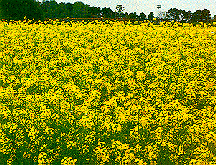
- Figure 6.7 – Canola seed
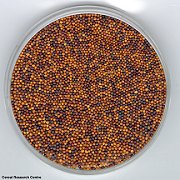
- Figure 6.8 – Canola meal
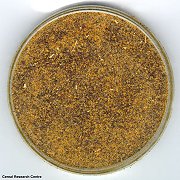
- Nutritional value
- 41-43% CP (DM basis)
- Good amino acid profile
- Lower in lysine and higher in methionine compared to soybean meal
- Antinutritional factors
- Erucic acid, glucosinolates, and tannic acid
- Feeding livestock
- Monogastrics and ruminants
- General maximum rate is 20% of ration
- Monogastrics and ruminants
- Additional canola-based products
- Full-fat canola seed
- Linseed meal
- By-product of flax oilseed
- Figure 6.9 – Flax plant
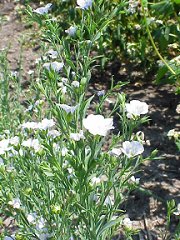
- Figure 6.10 - Flax seed
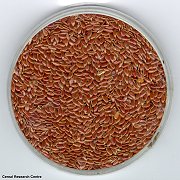
- Nutritional value
- 35% CP (AF basis)
- Low in lysine and tryptophan
- Low in carotene, vitamin D
- Moderate in Ca and B vitamins
- Antinutritional factors
- Cyanogenic glycoside and antipyridoxine factor
- Feeding livestock
- Favorable for ruminants, horses, and sometimes swine
- Rarely fed to poultry
- Peanut meal
- Figure 6.11 – Peanuts on the vine
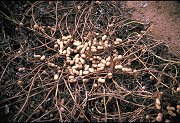
- Nutritional value
- 44-55% CP
- Quality varies
- Low in methionine, lysine, and tryptophan
- Low in Ca, carotene, and vitamin D
- Palatable
- Antinutritional factor
- Aflatoxins
- Other peanut-based products
- Peanut meal and hulls
- Figure 6.11 – Peanuts on the vine
- Safflower meal
- Figure 6.12 – Safflower plant
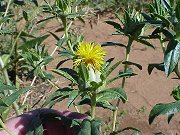
- Nutritional value
- Meal with hulls
- 25% CP (DM basis)
- 32% CF (DM basis)
- Partially dehulled meal
- Higher nutritional value
- 46% CP (DM basis)
- 15% CP (DM basis)
- Deficient in methionine and lysine
- Meal with hulls
- Feeding livestock
- Monogastrics
- Dehulled meal
- Ruminants
- Used efficiently
- Monogastrics
- Figure 6.12 – Safflower plant
- Sesame meal
- Nutritional value
- 38-48% CP (DM basis)
- Low in lysine and adequate in methionine
- Phytic acid
- Feeding livestock
- Limit amount fed to monogastrics
- Nutritional value
- Sunflower meal
- Nutritional value
- With hulls
- 26% CP (DM basis)
- Dehulled meal
- 50% CP (DM basis)
- Protein quality similar to soybean meal
- Low in lysine
- High in fiber
- With hulls
- Feeding livestock
- For monogastrics, fiber will limit use
- Nutritional value
- Additional oilseed meals
- Page 97 of text
- Use limited
| Welcome | Getting Started | Resources | SiteMap |